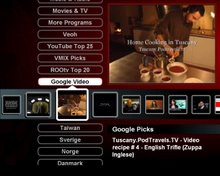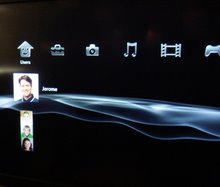The Issue: What might be next for Apple TV in terms of new platform features, services or collaborations?
Background: Apple TV is off to an interesting start. It has overcome obstacles in: cost, noise, features, ease-of-use and simplicity in terms of maintenance – all of which have defeated many previous attempts to bring internet to the living room TV.
Behind the scene: The competition to deliver Internet video to the living room location is fierce. Unlike PC-web development, the market has no widely accepted delivery platform; it lacks the equivalent of a universal PC with a web browser. Competitors are thus forced to respond to steadily emerging low-price options by combining internet video access with other appreciated features or service. This downward pricing trend may also force collaboration among those trying to gain a leading position.
Steve Jobs has indicated that Apple TV is a long-term project. Apple TV enables a living room TV to access the Apple video portal and YouTube shared video. Maybe Apple felt there was not enough video at the Apple portal to drive sufficient demand for the Apple TV box, and hence has added YouTube. Or, Apple may also have felt Apple TV sales were vulnerable against a competitor’s box which supports YouTube access.
Jobs has pointed out that “a lot of people failed” to make a business out of internet delivery of video to the TV. In part, he is likely referring to the Media Center or Home Theater PC. Jobs states they will “work on it [Apple TV] and improve over the next 18 months or two years, we can crack that”. What might he have in store?
With Microsoft Extender technology and Intel ViiV client technology not making much traction in the market, active-TV technology has emerged as the primary PC-assisted competitor to the Apple TV approach. Apple TV also partially follows the PC-assisted or Extended-PC approach. However, the consequence of enabling Apple TV to have some stand-alone capability (a 40 GB hard drive is included), is a much higher cost and more heat than desired emanating from the box. Apple TV technology has also not been integrated into a TV or Set-Top Box (STB) with broadcast TV reception capabilities, thus is in no position to reap the cost savings that would result, and hence is at a disadvantage.
Steve Jobs is reported as saying “our model for Apple TV is we want to be like a DVD player for the Internet”. Now, DVD players can be bought in the US for $30. Unfortunately, the high Bill Of Materials (BOM) for Apple TV results in a current price of $299. Most importantly, it will not prove easy to get the BOM cost down. Apple TV is made from PC components, minus any display; a ‘headless-PC’, if you will. Consequently, it has the BOM cost of a low-end PC rather than high-volume consumer appliance technology. Alluded to earlier but little appreciated is that it also generates the equivalent heat output of a low-power PC.
Concerning TV versus PC material costs, PC companies have already struggled with building a low-cost PC-like box. They were familiar with the problems: of 1) high BOM cost, 2) too much heat and noise, and 3) ensuring the Windows operating system is reliable and low-maintenance. Failure to overcome these difficulties is what led to the PC-assisted or Extended-PC approach using active-TV technology, rather than the rapid adoption of a PC dedicated in the living room. The former approach requires very little work be performed at the TV-end. Instead, the work-load is handled, almost invisibly, on behalf of the TV by a networked laptop or PC located elsewhere in the home.
To its credit, Apple TV has solved the problems of noise and operating system operation which defeated the Home Theater PC (HT-PC). The Apple box may be a bit hot but it is fan-less (thus, noise-less). By way of improvement, Intel is likely working on a lower power next-generation chip which will further relieve the heat problem. As to the software used, Apple TV runs a version of Mac OS X which makes it very easy to build application software, even if there is a slight cost adder. Active-TV technology compares favorably with this approach as it enjoys similar productivity, since TV applications are built to run on a Windows browser. All in all, whereas the cost of media support can be absorbed into the price of a laptop or PC, it is not clear that a living room entertainment device like the Apple TV can absorb this cost, when compared with mass-market video entertainment prices.
In contrast, Active-TV technology platforms use chips from companies like STMicroelectronics, ATI, Sigma Designs and NXP. These are low-cost and low-power TV Systems-On-a-Chip (SOC). It is impossible to build comparably priced TV-like appliances using PC components. So Apple TV is vulnerable from a competitor product which enables access to internet video, such as YouTube, but at a lower TV-appliance rather than PC-appliance cost to the end user.
Given the cost advantage of TV-like appliances, what might such devices look like and how might they influence the future direction of Apple TV?
1) TV manufacturers are rapidly developing networking technology for their next-generation high-end TVs. Adding support for active-TV technology adds very little to the cost or complexity of a networked TV; in fact, most of the extra hardware cost may be for additional memory only. Hence, networked TVs may be the least costly option for anyone joining the TV-web revolution, and stand-alone boxes or Digital Media Adapters (DMA), would have a difficult time competing successfully.
Moreover, combining broadcast reception and internet video processing in the same box enables processing of overlay TV-web in synchronization with broadcast TV. This offers advanced support for new forms of TV advertising and social networking. This is also another way to justify the cost of including a hard drive (HD) as the disc can also be put to work supporting digital video recording (DVR).
Support for broadcast reception also enables a low cost solution for what is often described as “sling box” operation. In this case the TV or Set-Top Box sends the received video over the network to a PC where it can be further processed or distributed by software such as TVersity. The approach avoids running complex software directly at the TV. In fact, any materials stored in the PC, or accessible by the PC over the home network, can be appropriately formatted by TVersity and sent-on to a cell phone, Sony PSP or other ecosystem-connected devices.
Tversity is also well known for its use in distributing PC-stored or network-acquired materials to a networked TV utilizing a local TV UI rather than a TV-web formatted UI produced via PC-assistance.
2) With the world wide shift away from analog to digital broadcast TV, many existing TVs are being equipped with digital reception capabilities. This is particularly true in Europe where there is rapid adoption of free-to-view DVB-t boxes. The TV chips used with DVB-t boxes don’t support the Mac OS. It would add greatly to the cost of Apple TV to combine digital transport stream (TS) processing with the PC-like innards of an Apple TV box. Maybe Intel can solve this problem by integrating the hardware required for broadcast reception into an Apple TV SOC solution.
3) Apple TV currently supports component video or HDMI connection to the widescreen TV. This can be an obstacle for those lacking sufficient TV-input channels. By integrating a DVD player into Apple TV, the existing inputs used by the DVD player could be put to better use. This is not news to Apple but maybe because of the extra $15 of support hardware, they have chosen not to do so. The use of component signaling does produce a clearer image when viewing digital photos or the TV UI, but it is not necessary for the current YouTube video quality.
Currently there is no support for the popular European SCART connector. However there are conversion boxes which allow Apple TV to be daisy chained with other SCART appliances. This helps reduce competition for TV input signaling for European users.
4) Apple TV technology could be combined with an existing TV service provider’s Set-Top Box (STB). The subsidized or free-with-service STB is the approach most familiar in the US. As previously discussed, such STB providers are more interested in generating new revenue from IP video or advertising delivery. They are not much interested in providing free access to TV-web channels, and hence would rather use the internet to support their existing broadcast shows. Apple could provide a closed-garden solution, but the cost of the extra Apple-TV hardware would be difficult to absorb without passing along some of the cost to the end-user.
In contrast, active-TV technology enables the STB or service provider to provide access to TV web channels at lower hardware costs and possibly negotiate directly with the internet video provider, rather than via Apple and its portal. Subsidized STBs associated with closed garden web access may be challenged in the market by an increasing trend to purchase boxes in retail which are not constrained within a walled-garden environment.
5) Competing with hybrid STBs that include internet access to TV-web is challenging enough, but when Voice-over IP (VOIP) is added to the STB, the pressure is only increased. For this reason, Apple may add some type of VOIP to a future Apple TV. Scendix has developed Skype support for active-TV technology ecosystems. Scendix’s TV-web formatted UI can be used in conjunction with, say, a wireless Skype phone from the living room. The image below shows how an incoming call is announced on the TV.

6) As previously discussed, the Sony Playstation 2 equipped with BroadQ’s version of active-TV technology will have the advantage of enabling a large number of existing PS2 owners to gain access to YouTube and other sources of internet delivered video. The PS2 now sells for about $130, and there may be some additional cost for network support, but some YouTube enthusiasts may see the PS2 as a cost-effective option for viewing YouTube on the living room TV.
Summary: A Piper Jaffray analyst report, states that iTunes is becoming the “de facto standard” for handling media on a PC. With currently 110 million iTunes users, they project that this will lead to Apple securing “$1.2 billion in Apple TV revenue [2008] “, given that the “digital living room market in calendar year 2008 will be $4.7 billion”. They also state, "We are currently modeling for Apple to sell 2 million Apple TV units in calendar year 2007”.
It is interesting that Piper Jaffray tie the success of Apple TV so closely to its interoperation with Apple’s successful PC-side software. I do agree with this ecosystem view of market development – PCs and laptops are clearly going to work in close cooperation with future consumer appliances such as networked TVs. But there is a lot of competition in the PC software business and active-TV technology enables these companies to have a critical presence at the TV. There is also a large and established living room video appliance market that is determined to maintain or grow its market share. Apple securing a reported 25% of the 2008 digital living room market will be a great accomplishment.
In conclusion, Apple TV is an impressive first salvo from an accomplished marketing team into the realm of internet video viewable on the TV. But the lack additional features, an integration path directly into the back of a TV, or TV appliance-like BOM costs, will put great pressure on the marketing team trying to grow sales volume. For now, however, the challenge lies before all those other device manufacturers who wish to build on what Apple TV has achieved, and who will be compelled to use the PC to assist with formatting and delivering universal content to the TV at costs that consumers can readily embrace.
Feedback, corrections and comments welcome. Contact me for more information or support with active-TV technology development.
Daniel Mann











1 comment:
Iv been looking around the internet for some good quality s so far they have either been really cheap and rubbish or expensive and good but I don’t want to be forking out loads of money every time I need a scart cable. I have ordered a few 1 metre scart cable for my TV and consoles. i recently borrowed a projector off my uni and played pro evo on it! amazing
Post a Comment